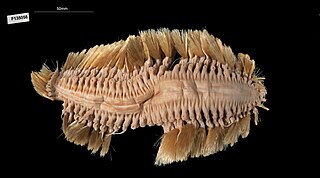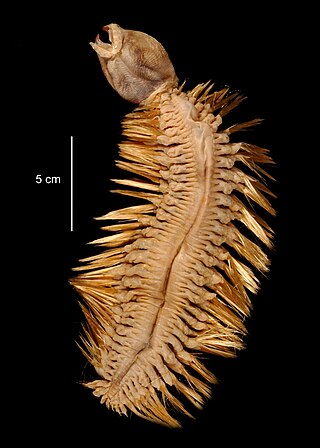
Phyllodocida is an order of polychaete worms in the subclass Aciculata. These worms are mostly marine, though some are found in brackish water. Most are active benthic creatures, moving over the surface or burrowing in sediments, or living in cracks and crevices in bedrock. A few construct tubes in which they live and some are pelagic, swimming through the water column. There are estimated to be more than 4,600 accepted species in the order.

Errantia is a diverse group of marine polychaete worms in the phylum Annelida. Traditionally a subclass of the paraphyletic class Polychaeta, it is currently regarded as a monophyletic group within the larger Pleistoannelida, composed of Errantia and Sedentaria. These worms are found worldwide in marine environments and brackish water.

Pilargidae is a family of polychaetes. These marine worms are cylindrical, somewhat flattened, and can be ribbon-like. They can be found free-living on sediment, or shallowly in sediment. Some species within the genera Hermundura and Litocorsa are known to burrow, having reduced heads and parapodia. Two species are known to be commensal with other polychaetes. Pilargis berkeleyae will live in the tubes of Chaetopteridae, and Ancistrosyllis commensalis will live in Capitellidae burrows. Pilargid worms are almost all exclusively predators, classified as carnivore omnivores. They are similar in appearance to Hesionidae, with a peristomium often with two pairs of tentacular cirri, reduced or absent notopodia, and a lack of pharyngeal jaws. The first few segments bearing setigers are also somewhat fused. They can have 0 to 3 antennae, and palps. These polychaetes are rarely the most abundant polychaete.

Eulagisca is a genus of marine polychaete worms belonging to the family Polynoidae. The genus includes 5 species which are all found in the Southern and Antarctic Oceans and are notable for reaching a large size - 180 mm or more long - larger than any other species of Polynoidae.

Eulagisca gigantea is a species of scale worm. This species is specifically found in the deep-sea in cold waters like the Antarctic Ocean. The scale worms are named for the elytra on their surface that look like scales

Eunoe leiotentaculata is a scale worm known from southern Australia and New Zealand and the South Pacific Ocean at depths of 500–1200 m.

Peinaleopolynoe is a genus belonging to the family Polynoidae. Members of this genus generally live in nutrient-rich environments in the deep sea, such as whale fall, which is the reason for their name.
Eunoe ivantsovi is a scale worm known from the Tasman Sea off Lord Howe Island at a depth of 1640m.

Eulagisca uschakovi is a giant scale worm known from the Antarctic, in waters such as off Mac.Robertson Land, Palmer Archipelago and the Weddell Sea, at depths of 10 to 920m.
Eunoe tuerkayi is a scale worm described from the Mediterranean Sea at depths of about 30m.
Admetella brevis is a scale worm known from the Hjort Trench in the south-west Pacific Ocean at a depth of 5760m.
Admetella hastigerens is a scale worm known from the east Pacific Ocean at depths of about 1000–1200m.
Austropolaria is a genus of marine annelids in the family Polynoidae. The genus includes a single species, Austropolaria magnicirrata, which is known only from the Amundsen Sea in the Southern Ocean, at depths of 1000 to 1500m.
Bathyeliasona abyssicola is a deep-sea scale worm which occurs widely across the Pacific and Atlantic Oceans and over a wide depth range, from 4000m to 8000m.
Bathyeliasona kirkegaardi is a deep-sea scale worm which is only known to occur in the Pacific Ocean, where it is recorded from a depth range of about 5,500–8,000 m.
Yodanoe is a genus of marine polychaete worms belonging to the family Polynoidae, the scaleworms. Yodanoe contains a single species, Yodanoe desbruyeresi which is known from the Clarion-Clipperton Fracture Zone in the equatorial East Pacific Ocean at a depth of almost 5000 m.
Ysideria is a genus of marine polychaete worms belonging to the family Polynoidae, the scale worms. Ysideria contains a single species, Ysideria hastata which is known from the North Pacific Ocean off the coast of California at depths of about 50–60 m.
Verrucapelma nigricans is a scale worm, known from intertidal habitats in the South China Sea.
Hermadionella is a genus of marine polychaete worms belonging to the family Polynoidae, the scaleworms. Hermadionella contains 3 species which are known from the north-west Pacific and Arctic Oceans from the intertidal to depths of about 200 m.
Bruunilla nealae is a deep-sea scale worm that is known from a single specimen collected from the Clarion-Clipperton Fracture Zone in the Pacific Ocean from a depth of about 5000 m.








